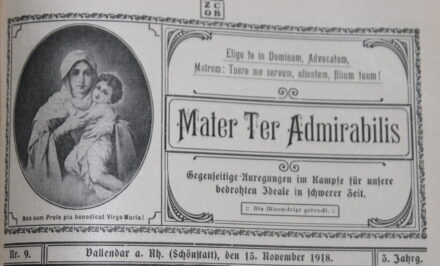 org. The Conference 2014 called upon the Schoenstatters of this epoch to be the “Generation 2014” – pilgrims on the way to the jubilee, missionaries of the covenant of love, prophets of Fr Kentenich’s charism of renewal. These are the people who are preparing the step over the threshold into a new Schoenstatt century, which has to be marked by the formative power of the covenant of love, a force that can transform the world into a single tent of a covenant culture.n this missionary Advent we turn our gaze to a very ordinary man whom someone has called the saint of the New Evangelisation: John Luiz Pozzobon, whose day of death is commemorated this JUne 27.
org. The Conference 2014 called upon the Schoenstatters of this epoch to be the “Generation 2014” – pilgrims on the way to the jubilee, missionaries of the covenant of love, prophets of Fr Kentenich’s charism of renewal. These are the people who are preparing the step over the threshold into a new Schoenstatt century, which has to be marked by the formative power of the covenant of love, a force that can transform the world into a single tent of a covenant culture.n this missionary Advent we turn our gaze to a very ordinary man whom someone has called the saint of the New Evangelisation: John Luiz Pozzobon, whose day of death is commemorated this JUne 27.
![]()
 What 2014 becomes will depend on the grace of 2014 that comes from the hand of our Mother Thrice Admirable – and from the supporters of renewal, the individual pilgrims and missionaries.
What 2014 becomes will depend on the grace of 2014 that comes from the hand of our Mother Thrice Admirable – and from the supporters of renewal, the individual pilgrims and missionaries.
If 2014 comes from God, a single person, or a person with a number of allies, will be sufficient to create a covenant culture and make Schoenstatt’s mentality still more missionary, intercultural and vital.
We have already experienced this in the life and mission of Joao Luiz Pozzobon.
“If something comes from God, a single person is sufficient to change the world”, he said. He changed Schoenstatt – for ever – by giving it its missionary character in the Campaign of the Pilgrim Mother.
He also changed the world by flooding it with thousands of missionaries who are ready and able to bear the graces from Schoenstatt’s shrine to the ends of the earth, so that Christ can be born anew. …
Don Joao Pozzobon, the saint of the new evangelisation in view of 2014: It would be possible to write a whole book on this subject. We can offer a few rays of light without any attempt at completeness.
“He has looked upon the lowliness of his handmaid”
 Simple, humble and selfless service – that is the spirit that moved the “poor pilgrim and deacon”, Joao Pozzobon, who saw himself as a “servant”, “instrument” and “little donkey” of his Mother and Queen. It is the same spirit that has to govern the Campaign and the supporters of the new evangelisation in this missionary Advent. Joao Pozzobon had little more than basic schooling; he was a simple worker, a simple layman, who at a definite moment heard God’s call and never again stopped carrying out the mission he had accepted at that time. He never fell prey to the temptation to exercise power, or to be afraid. The very simplicity of the Campaign could be decisive for the new evangelisation at a time when many have had enough of complicated theories. The attitude of selfless service could perhaps have more effect in view of the growing dislike of corruption and power games. The saint of the new evangelisation created something that was as simple as it was efficient; it requires one thing of its supporters to have an effect: To serve Mary and people selflessly without any secondary personal objective. Since it is so simple, the Campaign is available to everyone. It is based on a solid spirituality and an effective pedagogy as it makes the new evangelisation a reality.
Simple, humble and selfless service – that is the spirit that moved the “poor pilgrim and deacon”, Joao Pozzobon, who saw himself as a “servant”, “instrument” and “little donkey” of his Mother and Queen. It is the same spirit that has to govern the Campaign and the supporters of the new evangelisation in this missionary Advent. Joao Pozzobon had little more than basic schooling; he was a simple worker, a simple layman, who at a definite moment heard God’s call and never again stopped carrying out the mission he had accepted at that time. He never fell prey to the temptation to exercise power, or to be afraid. The very simplicity of the Campaign could be decisive for the new evangelisation at a time when many have had enough of complicated theories. The attitude of selfless service could perhaps have more effect in view of the growing dislike of corruption and power games. The saint of the new evangelisation created something that was as simple as it was efficient; it requires one thing of its supporters to have an effect: To serve Mary and people selflessly without any secondary personal objective. Since it is so simple, the Campaign is available to everyone. It is based on a solid spirituality and an effective pedagogy as it makes the new evangelisation a reality.
“You have to go on”
“When I saw that the visits of the Pilgrim Mother bore so much fruit in families, I couldn’t stop.” These words of Joao Pozzobon have been repeatedly passed on by his friend and spiritual guide, Hermann Arendes. The visits of the large picture of the Mother Thrice Admirable of Schoenstatt were intended as a sort of novena for 1 November 1950, the day when the dogma of Mary’s Assumption into heaven was proclaimed. How many interesting projects could Joao Pozzobon have started from 2 November 1950? What would have become of Schoenstatt and the Church if, as had been planned, he had put the picture in a corner and looked for other things to do? We owe the Pilgrim Mother Campaign to the faithfulness of the pilgrim and missionary, Pozzobon, to the work he had started, which was nourished by his observation of actual life. We also owe it to him that the missionary current in Schoenstatt has become so dynamic and strong, so that today, on the way to 2014, it is in the process of permeating the whole Movement … and beyond. Far, far beyond.
Passing through rejection
 It happened to Jesus with regard to the leaders of the People of Israel, it happened to the prophets of every epoch, it has happened to the new spiritual movements and their founders: They were all rejected by those they wanted to gift, renew and enrich, awaken and move. It also happened to Joao Pozzobon. During the time of Fr Kentenich’s exile representatives of the Church wanted to force him to change the picture, and they accused him of belonging to Schoenstatt. It happened to him also with regard to Schoenstatt, and it cost him even greater suffering, when he was told that what he was doing did not really reflect Schoenstatt correctly. He was excluded, ignored, rejected and isolated by participants at conferences. As Fr Beller put it, “He disturbed the system.” Things weren’t better for his Campaign or hundreds of missionaries. They had to enter into the covenant of love outside the shrine, because in Schoenstatt in the 1980s no one was prepared for the “holy places” to be “taken over” by hundreds of enthusiastic pilgrims who would dirty the carpets in the shrine, and who rudely hoisted the Movement out of the catacombs. … Of course, that disturbed. And challenged the one who knew he was called. Joao Pozzobon went through it, with tears as he himself testified, without ever losing his love for the Church or for Schoenstatt. He remained faithful to a Schoenstatt that rejected him and that today works for his beatification and knows what it owes to him.
It happened to Jesus with regard to the leaders of the People of Israel, it happened to the prophets of every epoch, it has happened to the new spiritual movements and their founders: They were all rejected by those they wanted to gift, renew and enrich, awaken and move. It also happened to Joao Pozzobon. During the time of Fr Kentenich’s exile representatives of the Church wanted to force him to change the picture, and they accused him of belonging to Schoenstatt. It happened to him also with regard to Schoenstatt, and it cost him even greater suffering, when he was told that what he was doing did not really reflect Schoenstatt correctly. He was excluded, ignored, rejected and isolated by participants at conferences. As Fr Beller put it, “He disturbed the system.” Things weren’t better for his Campaign or hundreds of missionaries. They had to enter into the covenant of love outside the shrine, because in Schoenstatt in the 1980s no one was prepared for the “holy places” to be “taken over” by hundreds of enthusiastic pilgrims who would dirty the carpets in the shrine, and who rudely hoisted the Movement out of the catacombs. … Of course, that disturbed. And challenged the one who knew he was called. Joao Pozzobon went through it, with tears as he himself testified, without ever losing his love for the Church or for Schoenstatt. He remained faithful to a Schoenstatt that rejected him and that today works for his beatification and knows what it owes to him.
“Without the Campaign Schoenstatt would have remained like Christianity without St Paul,” Fr Guillermo Carmona remarked, “small-town, without perspective, without a land to conquer. … The Campaign managed to awaken slumbering forces. Because, when a missionary looks somewhere, he or she discovers an apostolic opportunity.”
The Campaign gives the individual missionary and Schoenstatt as a whole new energy. It is not simply a pastoral stratagem, but mysticism from the depths of the covenant of love. A strongly apostolic awareness has been awakened, an enthusiasm that can no longer be held in check, and commitment that makes the testimony credible. The Kentenich principle: Life is enkindled by lifemotivates the missionary to draw new life and enthusiasm out of his or her missionary work.
In 1968 Fr Kentenich said that in the Pilgrim Mother Campaign “all Schoenstatt’s fundamental forces become effective”.
In the service of the new evangelisation
 One of the first Auxiliaries (replicas of the picture carried by Joao Pozzobon) was crowned in 1986 as the “Queen of the New Evangelisation in Latin America and the whole world”. A few weeks ago the young Campaign in Europe crowned its Auxiliary with the title “Queen of the New Evangelisation in Europe”. What Joao Pozzobon started is neither mere devotion to Mary, nor mere strategy or pastoral practice, but a breakthrough of grace and life in the service of the New Evangelisation and strengthening families. It is a mission integrated into the organism of the Church, a modern way for the pastorate, which has as its special goal the evangelisation of the family. We are dealing here with an apostolate that goes to meet all people and mediates Christian values. At the same time it makes our Schoenstatt Secret practical and popular. Through the Pilgrim Mother Campaign the Mother Thrice Admirable and Queen wants to go out from the shrine as “the Great Missionary” “to work miracles”, in order to lead countless people to the covenant of love and hence to Christ and the fullness of the Gospel. The Campaign aims to be an instrument in the hand of the Blessed Mother for her mission to evangelise, so that as the great educator in the faith she can educate the peoples and lead them through Christ in the strength of the Holy Spirit to the Father (cf. Santa Maria Document 1989).
One of the first Auxiliaries (replicas of the picture carried by Joao Pozzobon) was crowned in 1986 as the “Queen of the New Evangelisation in Latin America and the whole world”. A few weeks ago the young Campaign in Europe crowned its Auxiliary with the title “Queen of the New Evangelisation in Europe”. What Joao Pozzobon started is neither mere devotion to Mary, nor mere strategy or pastoral practice, but a breakthrough of grace and life in the service of the New Evangelisation and strengthening families. It is a mission integrated into the organism of the Church, a modern way for the pastorate, which has as its special goal the evangelisation of the family. We are dealing here with an apostolate that goes to meet all people and mediates Christian values. At the same time it makes our Schoenstatt Secret practical and popular. Through the Pilgrim Mother Campaign the Mother Thrice Admirable and Queen wants to go out from the shrine as “the Great Missionary” “to work miracles”, in order to lead countless people to the covenant of love and hence to Christ and the fullness of the Gospel. The Campaign aims to be an instrument in the hand of the Blessed Mother for her mission to evangelise, so that as the great educator in the faith she can educate the peoples and lead them through Christ in the strength of the Holy Spirit to the Father (cf. Santa Maria Document 1989).
The Campaign with its many variations is not the only fruit of the missionary commitment of Joao Pozzobon in the service of the new evangelisation.
The Misiones of the Schoenstatt Youth and students, as well as the Family Misiones, which are further evangelisation forces in Schoenstatt, are forever connected with the picture of the Pilgrim Mother as its characteristic sign.
The Men’s Rosary in Brazil, which unites hundreds of thousands of men throughout the country in prayer and service to others, is strongly connected with Joao Luiz Pozzobon.
The “Vila Nobre de la caridad”, a settlement for the poorest of the poor founded by Joao Pozzobon, who was motivated by the solidarity generated by the covenant of love, can justifiably be seen as the model for hundreds of apostolic projects in the social field. …
A Missionary Advent
Joao Luiz Pozzobon offered up his life in the year when we commemorated Fr Kentenich’s hundredth birthday. As “the saint of the new evangelisation” in the missionary Advent of the Jubilee 2014, he becomes a sign showing us how we can set to work, so that 2014 will lead to a renewal of the covenant of love and give rise to a renewed Schoenstatt in the service of the Church and the people of our time. It is a missionary Advent in which each individual missionary prepares the way for the Great Missionary, the Queen of the New Evangelisation.














